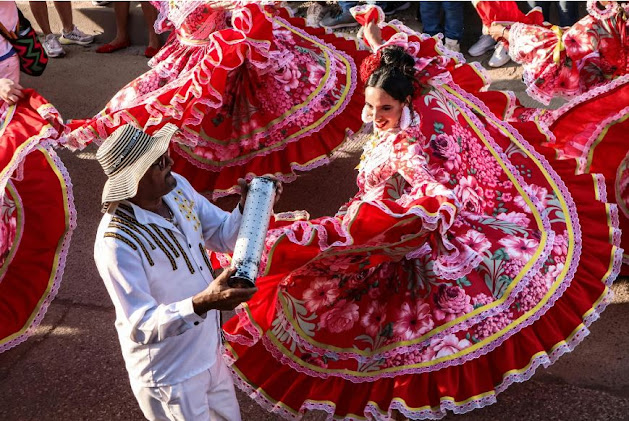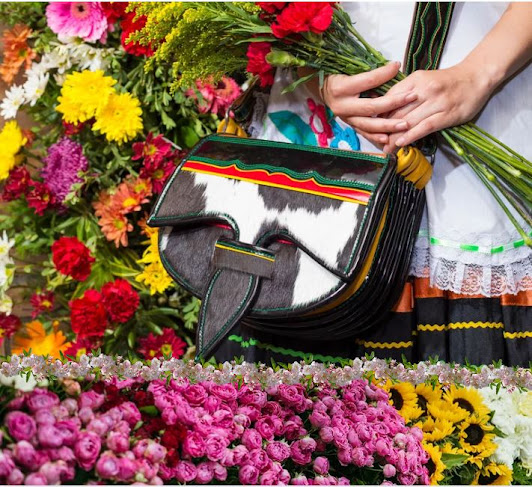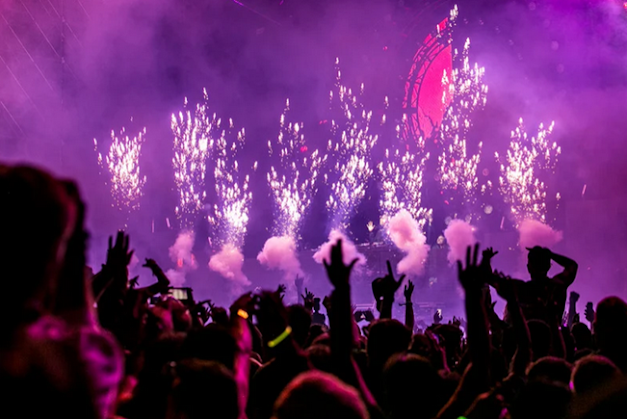Colombia: A Country of Festivals
A festival is a series of performances or representations dedicated to a specific art, usually held over several days annually . The word “festival” has several synonyms, including parties, celebrations, contests, special evenings, performances, competitions and exhibitions.
There are different types of festivals, including music, cultural, outdoor, films, and literature events, as well as religious and traditional gatherings. Additionally, there are food fairs, sports competitions, car shows, and agricultural and livestock exhibitions. Some of these occasions conclude with award ceremonies.
Festivals are important in language learning because they teach students to appreciate the culture, art, and identity of a community. Attending a festival can create emotional connection with the language and culture, which makes it easier to learn both vocabulary and expressions related to the event.
Moreover, working with festival-related activities in the classroom helps practice the language in a specific context. Listening to native speakers talk about these events enhances listening skills, while students are also exposed to different accents, improving not only comprehension but also pronunciation.
The celebration of festivals is very ancient. The first festivals were held to honour the gods. In ancient Greece, music and theatrical performances were included in honour of Dionysus, the god of wine and ecstasy.
On the other hand, several sources indicate that Egyptians were also pioneers in these types of celebrations. They held various festivals accompanied by music and dance. Both in Greece and Egypt, these celebrations lasted several days.
The celebration of festivals is quite rich in the Spanish-speaking world. In addition to festivals, since many Spanish-speaking countries have a Christian religious tradition, every year in each town, patron saint festivals are celebrated in honour of the town’s patron saint. These festivals are usually related to the agricultural and livestock cycles of rural communities, where the collective identity of the community is celebrated.
In Spanish-Speaking world, there are many festivals. Below, we will look at some of the festivals celebrated in Colombia, a diverse country with rich cultural, social and historical heritage, where more than 200 festivals are held annually. It is worth mentioning that some of these celebrations have received international recognition.
The Carnival of Blacks and Whites
This popular festival, celebrated in the southwestern part of Colombia, in the city of Pasto, was declared an Intangible Cultural Heritage of Humanity by UNESCO in 2009. The carnival is celebrated from the 28th of December to the 6th of January, and its origins date back to the colonial era, reflecting mestizo, African, and Indigenous influences. This celebration highlights equality, diversity, and respect, blending culture, history, and tradition.
During the festival, there are colourful parades, carnival processions, floats, and various choreographies. The atmosphere is very joyful, and everyone can participate by painting their faces black. For more information click here.
The Wind and Kite Festival
Villa de Leyva is a colonial town located about four hours from the capital, Bogotá. During the month of August, the wind picks up, and this is taken advantage of by professional and amateur kite enthusiasts to showcase their creations. The festival last for a weekend and takes place in mid-August.
The event is held in the beautiful cobblestone square of Villa de Leyva, and the sky is filled with hundreds of kites made from paper, plastic, fabric, and other materials.
This festival attracts both adults and children. There are kites of all colours and sizes. Additionally, workshops and activities are organised for children to learn how to make their own kites, promoting family participation and creating a lively and festive atmosphere. For more information click here.
Carnival of Barranquilla
In 2023, this carnival was declared a Masterpiece of the Oral and Intangible Heritage of Humanity by UNESCO. The festival showcases significant expressions of the Colombian Caribbean identity, and of course, the people from Barranquilla. For more information click here.
Cali Fair
More than 10,000 artists are hired for this celebration, which attracts over a million people who come to enjoy the lively salsa dance. The fair held annually between December 25th and 30th, making it an important part of the end-of-year festivities. It is a six-day celebration that includes music, dance, and vibrant colours.
The fair originated in 1957 and has since evolved to include short parade processions, the famous horse parade (cabalgata), and the popular beauty pageant. Visitors can enjoy a wide variety of events, most of them free. For more information click here.
Vallenato Legend Festival
Vallenato is a musical genre from the Caribbean region of Colombia, characterised by joyful singing accompanied by the accordion. The songs often tell stories of daily life. In 2015, vallenato was declared by UNESCO as Intangible Cultural Heritage of Humanity.
This festival, founded in 1968, is celebrated annually in the city of Valledupar. During the festival, the Vallenato King is chosen by a jury that evaluates the participants, and this title is awarded to the winner of the festival.
In addition to music, the festival features the “desfile de piloneras.” This event is a traditional procession where participants, dressed in colourful folkloric attires, dance on the streets to the rhythm of El Pilón, a classic Vallenato song and dance that celebrates the region’s cultural heritage. The celebration takes place at the end of April and the beginning of May. For more information click here.
Manizales Fair and Festival
Visitors can immerse themselves in a variety of traditional activities, including horseback riding, musical performances, art exhibitions, folk dancing, and sports competitions. A highlight of the festival is the prestigious International Coffee Pageant, which draws participants and spectators from around the world.
Situated in Colombia’s renowned coffee region, Manizales
offers visitors the opportunity to explore its picturesque surrounding villages, including coffee plantations, beautiful mountains and impressive landscapes. For more information click here.
The flower Festival in Medellín
The Medellín Flower Festival is a beautiful celebration held annually in Colombia, in the city of Medellín, during the month of August.
A silleta es a wooden structure used to transport floral creations. The people who carry flowers on their backs in a “silleta” are called “silleteros,” and the most important part of the festival is the flower carrier parade. During the festival, more than 500 silleteros parade through the streets of the city, showcasing their beautiful, colourful and creative floral creations.
The silleteros wear traditional costumes, giving the festival a unique atmosphere. Additionally, there are parades of classic and vintage cars, as well as musical concerts. This festival highlights the values and traditions of the Paisa culture (people from the Antioquia region, particularly Medellín and the surrounding areas) and honour the biodiversity and beauty of flowers. For more information click here.
The Cumbia Festival
Cumbia is a Colombian musical genre and folk dance that has spread throughout Latin America. It combines elements from indigenous, African and European cultures. The rhythm is characterised by the use of percussion instruments like the drum, maracas, Colombian shaker and snare drum.
The Cumbia Festival is a cultural event held in El Banco, a town near the Caribbean Sea. During the celebrations, contests are held that highlight original songs, cumbia couples, and dance groups.
In 2022, Cumbia was declared Cultural Heritage of the Colombians to recognise the work of musicians, composers, dancers, choreographers, luthiers, and craftsmen who have kept this cultural expression alive. The recognition was made by the National Council for Cultural Heritage. For more information click here.
San Pacho Festival
The San Pacho Festival is an annual celebration held in the city of Quibdó between September and October. The event offers various activities that begin with a mass at the cathedral, followed by parades of flags, carnival groups, folkloric performances, and traditional music and dances in the streets.
Named after Saint Francis of Assisi, the festival is important because it celebrates the identity of the African-descended community, highlighting the spirit and Afro-Colombian identity.
In 2012, the San Pacho Festival was declared an Intangible Cultural Heritage of Humanity by UNESCO. The festival strengthens the identity of the Chocó region (situated on the western part of Colombia) and promotes social cohesion within the community, while encouraging creativity and innovation by revitalising and recreating traditional knowledge and respect for nature. For more information click here.
National Music Bands Encounter in Paipa
This festival is celebrated during the last week of September in the city of Paipa, located in central Colombia. The event gathers about 1,800 musicians (professionals, learners, teachers, and music enthusiasts from all over Colombia) and over 30 bands.
The festival includes street parties and fireworks around Lake Sochagota. The musical competition is held in the categories of children, youth, adult, festive, and special.
In 2023, the Ministry of Culture of Colombia declared
the National Music Band Competition as an Intangible Cultura Heritage of the
nation to safeguard the band tradition and strengthen music creation in its different genres. For more information click here.
To conclude, cultural festivals can be a powerful tool in the classroom for language learning, as they allow students to interact with the language in a dynamic and contextualized way.
Through activities such as theatrical performances, festival simulations, song analysis, and exploring traditions, students develop language skills while immersing themselves in the culture of the language they are studying. Moreover, these experiences foster motivation, active participation, and meaningful learning by connecting the language to real cultural expressions, making the acquisition process more natural, engaging, and dynamic.
To enjoy different songs in Spanish about a good variety of hispanic festivals click here.
Bibliography:
- Photos from: Canva. (2024). [online] Available at: https://www.canva.com/
- Alcaldía de Medellín. (2024) Feria de las Flores Medellín 2024. [online] Available at: https://www.medellin.gov.co/es/feria-de-flores/
- Alcaldía de Villa de Leyva. (2019) Festival del Viento y las Cometas. [online] Available at: https://www.villadeleyva-boyaca.gov.co/Paginas/FESTIVAL-DEL-VIENTO-Y-LAS-COMETAS.aspx
- Calendario de Colombia. (s.f.) Festival Nacional de la Cumbia en Banco - Magdalena. [online] Available at: https://www.calendariodecolombia.com/fiestas-nacionales/festival-nacional-de-la-cumbia-en-banco
- Corporación Concurso Nacional de Bandas de Música de Paipa. (2024) Inicio - Corbandas. [online] Available at: https://www.corbandas.com/
- Fundación Festival de la Leyenda Vallenata. (2025) Festival Vallenato. [online] Available at: https://festivalvallenato.com/
- Fundación Junta Permanente Pro-Semana Santa de Popayán. (2025) Semana Santa de Popayán 2025. [online] Available at: https://www.procesionespopayan.com/
- Hub Yamaha Europe. (s.f.) Beyond Woodstock: Charting the Rise and Transformation of Music Festivals. [online] Available at: https://hub.europe.yamaha.com/article/beyond-woodstock-charting-the-rise-and-transformation-of-music-festivals
- Ministerio de Cultura de Colombia. (s.f.) La Feria de Cali nace en 1957, pero ¿cómo surge y cuál es la historia? [online] Available at: https://www.cali.gov.co/cultura/publicaciones/178077/la-feria-de-cali-nace-en-1957-pero-como-surge-y-cual-es-la-historia/
- Talkpal. (s.f.) Cómo las festividades culturales pueden ayudarte a aprender un idioma. [online] Available at: https://talkpal.ai/es/como-las-festividades-culturales-pueden-ayudarte-a-aprender-un-idioma/
- UNESCO. (s.f.) Carnaval de Negros y Blancos. [online] Available at: https://ich.unesco.org/en/RL/carnaval-de-negros-y-blancos-00287
- UNESCO. (s.f.) Fiesta de San Francisco de Asís en Quibdó (Colombia). Disponible en: https://ich.unesco.org/es/RL/fiesta-de-san-francisco-de-asis-en-quibdo-colombia-00640
- Weezevent. (s.f.) Tipos de festivales. [online] Available at: https://weezevent.com/es/blog/tipos-festivales/
- Yamaha Music Europe. (s.f.) Beyond Woodstock: Charting the Rise and Transformation of Music Festivals. [online] Available at: https://hub.europe.yamaha.com/article/beyond-woodstock-charting-the-rise-and-transformation-of-music-festivals
- Colombia Travel. (n.d.). Manizales Fair. [online] Available at: https://colombia.travel/en/manizales/manizales-fair
- Fundación Carnaval de Barranquilla. (n.d.). Inicio. [online] Available at: https://carnavaldebarranquilla.org/












No comments:
Post a Comment